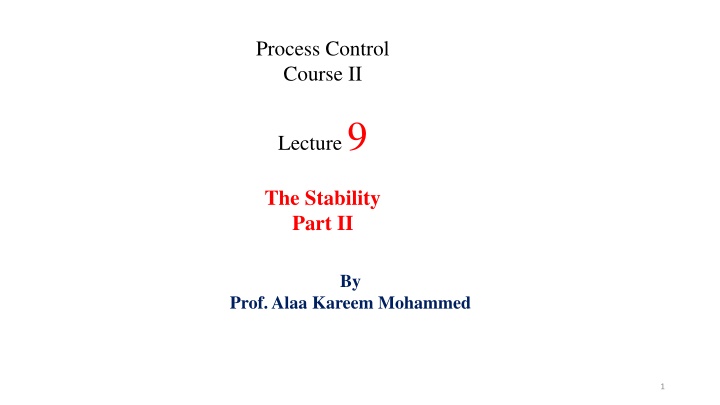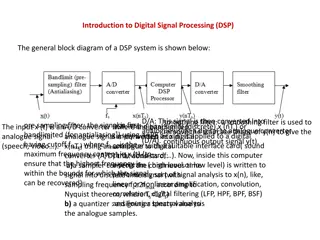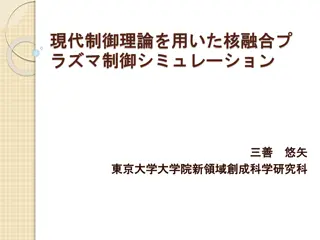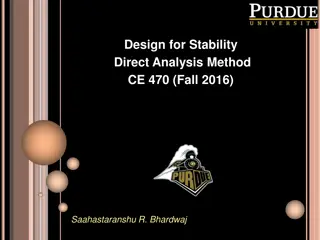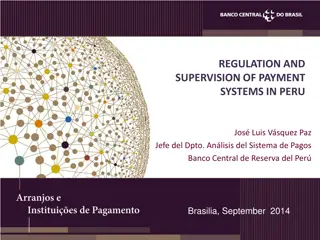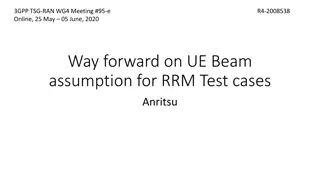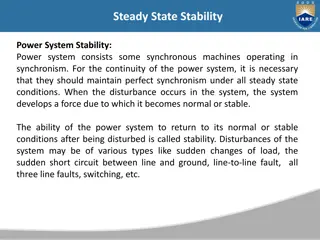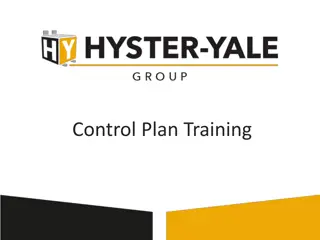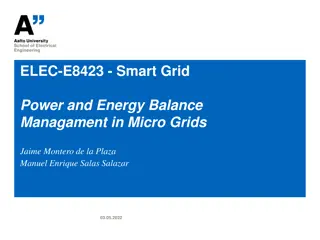Stability Analysis in Control Systems - Routh Test and Examples
This content covers the Routh test and stability analysis in control systems. Explore topics such as the Routh table, characteristic equations, Routh criterion, and practical examples demonstrating stability assessment using the Routh test. Learn how to determine system stability based on signs and values in the Routh table. Discover examples illustrating stable, unstable, and critically stable systems.
Download Presentation

Please find below an Image/Link to download the presentation.
The content on the website is provided AS IS for your information and personal use only. It may not be sold, licensed, or shared on other websites without obtaining consent from the author.If you encounter any issues during the download, it is possible that the publisher has removed the file from their server.
You are allowed to download the files provided on this website for personal or commercial use, subject to the condition that they are used lawfully. All files are the property of their respective owners.
The content on the website is provided AS IS for your information and personal use only. It may not be sold, licensed, or shared on other websites without obtaining consent from the author.
E N D
Presentation Transcript
Process Control Course II Lecture 9 The Stability Part II By Prof. Alaa Kareem Mohammed 1
Routh test Characteristic equation of a closed-loop system is 1 + ????????= 0 ?L (s) ?? + 1 + ???= 0 ?sp (s) + + ?? (s) ?? ?? ?? _ ????+ ?? 1?? 1 ?? 2?? 2+ + ?1? + ??= 0 ?? 2
Routh Table ????+ ?? 1?? 1+ ?? 2?? 2+ + ?1? + ??= 0 n These two rows from characteristic equation ?? ?? 2 ?? 6 ?? 4 0 1 2 ?? 1 ?? 3 ?? 5 ?? 7 0 3 ?1 ?2 ?3 0 0 4 ?1 ?2 ?3 0 0 These rows to be calculated 5 ?1 ?2 0 0 n+1 3
??1 ??2) ?? ??3 ?? 1 ?1 ?? 3) ?? 1 ?2 ?1 ?1= ?1= ?? 1 ?? 4) ?? ?? 5 ?? 1 ?1 ?? 5) ?? 1 ?3 ?1 ?2= ?2= ?1 ?? 7) ?? 1 0 ?1 ?3= ?? 1 ?? 6) ?? ?? 7 ?? 1 ?3= 4
Routh Criterion Routh criterion states that if in the first column : 1- There is a negative sign, then the system is unstable 2 All elements are positive sign, then the system is stable 3 There is a zero value and no negative sign, then the system is critically stable 5
Example 1 A closed system has a characteristic equation of 1 + ? ? ??? = 75 ?4+ 130?3+ 68?2+ 14? + 6 = 0 Test the stability using Routh test Solution 75 ?4+ 130?3+ 68?2+ 14? + 6 = 0 n 0 75 68 6 1 2 130 14 0 3 59.9 6 0 4 0.98 0 The system is stable 5 0 6 6
Example 2 5 ?3+ 6?2+ 3? + 15 = 0 A closed system has a characteristic equation of Test the stability using Routh test Solution n 5 3 0 1 2 6 15 0 3 9.5 0 4 15 0 The system is unstable Negative sign 7
Example 3 A closed system has a characteristic equation of ?4+ 2?3+ 5?2+ 8? + 4 = 0 Test the stability using Routh test Solution n 0 1 5 4 1 2 2 8 0 3 1 4 0 4 0 0 5 0 0 The system is critically stable Zero element exists and no negative sign 8
Home work 1 Test the stability of the following system ?4+ 2 ?3+ 6?2+ 4? + 1 = 0 Ans: stable ?4+ 2 ?3+ 3?2+ 4? + 5 = 0 Ans: unstable ?3+ 6?2+ 12? + 72 = 0 Ans: critically stable 9
Example 4 Consider the closed system shown in the block diagram below. a. Test the stability. b. Is the system stable if Integral mode (I= 4 min) is added to the proportional controller(Kc=2.5) 1 ?L (s) ? + 1 + + ?sp (s) + 2 1 ?? (s) 2.5 5? + 1)2 3? + 1 _ 1 ? + 1 10
Solution 1 ?L (s) (a). ? + 1 1 + ???= 0 + + ?sp (s) + 2 1 ?? (s) 2.5 1 + ????????= 0 5? + 1)2 3? + 1 _ 2.5) 2 1 + = 0 1 5? + 12 3? + 1) ? + 1 ) ? + 1 25?2+ 10? + 1 3?2+ 3? + ? + 1 + 5 = 0 75 ?4+ 130?3+ 68?2+ 14? + 6 = 0 11
75 ?4+ 130?3+ 68?2+ 14? + 6 = 0 n 0 75 68 6 1 2 130 14 0 3 59.9 6 0 4 0.98 0 5 0 6 The system is stable All the figures are positive 12
(b). 1 1 4? =10?+2.5 The controller is ??? = 2.5 1 + 1 4 ?) = 2.5 1 + ?L(s) 4? ? + 1 1 + ???= 0 + + + 2 ?sp (s) 1 4?) 1 ?? (s) 2.5 1 + 5? + 1)2 _ 3? + 1 1 ? + 1 10? + 2.5 4? 2 1 + + = 0 5? + 123? + 1 ? + 1 20? + 5 1 + = 0 4?[ 25?2+ 10? + 1) 3?2+ 4? + 1 ) 13
300?5+ 520 ?4+ 272?3+ 56?2+ 24? + 5 = 0 n 0 300 272 24 1 2 0 520 56 5 3 239.7 21.1 0 4 10.22 5 0 96.1 5 0 5 6 Negative figure The system is unstable 14
Advantages of Routh Criterion 1. We can find the stability of the system without solving the characteristic equation. 2. By Routh method, we can determine the range of (Kc) or (I) or (R) for stability. 15
Example 5 Given the characteristic equation of a closed loop system. ?3+ 7?2+ 14? + 8 + ? = 0 Find the range of K that makes the system stable . Solution ?3+ 7?2+ 14? + 8 + ? = 0 n 1 14 0 1 2 7 8 + ? 0 3 98 8 + ?) 7 0 4 0 8 + ? Note : the value of K is always positive K > 0 16
) 98 8 + ? 7 > 0 98 8 + ? > 0 ? < 90 ? ? ????? ?? ? ?? 0 < ? < 90 ? ?? ????? ? ? ?????? ?????? 98 8+?) 7 = 0so the system will be critically stable. ???? ? ?? ? ? ????? ? = 90 ???? ? ? ????? The value of K which make the system critically stable is called Kmaxor K criticalor limiting gain 17
Example 6 ?4+ 2?3+ 5?2+ 8? + 1 + ? = 0 Given the characteristic equation of a closed loop system. 1. Find the limiting gain Kmax 2. Sketch the response when using K max and find the frequency of the response ( ) and the time of one cycle Tc Solution ?4+ 2?3+ 5?2+ 8? + 1 + ? = 0 1. n 0 1 5 1 + ? 1 2 0 2 8 0 1 3 1 + ? 0 4 6 2? 0 5 1 + ? 18
6 2? = 0 ????= 3 ???????? ???? 3. 5 ?2+ 1 + ? = 0 ?2= 4 5 ?2+ 4 = 0 ??=7 5 y ? = 4 4 5 ? ? = 5 yo 4 5 ? = 0 ? =2? t ?? ??=2? 2? ?= = 7 4 5 19
Home work 2 Repeat example 6 for characteristic equation : ?4+ 4?3+ 5?2+ 4? + 2 + ? = 0 Ans: K=2 , =0.894 Tc=7 Home work 3 Given the characteristic equation of a closed loop system ?4+ 3?3+ 3?2+ 2? + ? = 0 Find the range of K that makes the system stable ? < ? <?? A?? ??? ????? ?? ? ?? ? ????? ????? ??? ?????? ?????? 20
Example 7 Consider the closed-loop system whose transfer functions shown below. Find the range of Kc that makes the system stable and the limiting gain( Kc max) ??? = ?? 1 +1 0.25 15? + 1 , 20 0.6 ? + 1 , ??= ??= 3? + 1 ,??? = ? Solution: 1 + ? ? ??? =0 ? + 1 ? 0.25) 20) 0.6)?? 15? + 1) 3? + 1) ? + 1)= 0 1 + ? 3? + 1 ? + 1 15? + 1 + 3??? + 1 = 0 ? 45?3+ 60?2+ 15? + 3?2+ 4? + 1 + 3??? + 3??= 0 45?4+ 63?3+ 19?2+ 1 + 3??? + 3??= 0 21
45?4+ 63?3+ 19?2+ 1 + 3??? + 3??= 0 n 19 3?? 0 45 1 63 2 1 + 3?? 0 0 3 18.28 2.14 ?? 3?? 0 6.42??2 136.3??+ 18.28 18.28 2.14?? 4 0 3?? 0 5 6.42??2 136.3??+ 18.28 18.28 2.14?? > 0 22
6.42??2 136.3??+ 18.28 18.28 2.14?? > 0 6.42??2 136.3??+ 18.28 > 0 6.42??2+ 136.3?? 18.28 < 0 ) ??2+ 21.23?? 2.84 < 0 Kc= 21.36 Kc= 0.1329 satisfy Eq. (*) Kc< 0.1329 . ) Also 18.28 2.14??> 0 Kc< 8.542 From Eq. (**) and (***) , the range of stability is ) 0 < Kc< 0.1329 ?? ???= 0.1329 23
Example 8 Consider the closed system shown in the block diagram below. Find the range of the derivative time (R) which makes the system stable. ?? (s) + 7? + 5 Solution ?sp (s) ?? ?4+ 11?3+ 10 _ 1 + ???= 0 7S + 5 1 + ?? + = 0 ?4+ 11?3+ 10 ?4+ 11?3+ 10 + 7??2+ 5?? = 0 ?4+ 11?3+ 7??2+ 5?? + 10 = 0 24
?4+ 11?3+ 7??2+ 5?? + 10 = 0 n 0 1 7? 10 1 2 0 11 5? 0 6.545 ? 3 10 0 5? 16.8 4 0 ? 5 10 16.8 5 ?2>16.8 5? >16.8 5? 16.8 ? > > 0 5 ? ? ? > 1.833 25
Example 9 A closed-loop system consists of the following items ??=0.25? ? 15? + 1 , 20 0.6 ? + 1 , ?? ?) = 3 ??? = ?? , ??= 3? + 1 , ??? = 2? + 1 1- Sketch the block diagram. 2 What is the range that make the system stable? 3 What is the limiting gain Kc max? 4- Determine the frequency of response ( ) and cycle period Tc 5 Sketch the response. 26
Solution 3 (1). ?L (s) 2? + 1 + + + ?sp (s) 0.25? ? 15? + 1 20 ??(s) ?? 3? + 1 _ 0.6 ? + 1 27
(1). 1 + ???=0 0.25) 20) 0.6) ??? ? 15? + 1) 3? + 1) ? + 1 3 ??? ? 15? + 1) 3? + 1) ? + 1 1 + = 0 1 + = 0 45?3+ 63?2+ 19? + 1 + 3?? [1 0.5S 1 + 0.5S] = 0 45?3+ 63?2+ 19? + 1 + 3?? [2 S 2 + S] = 0 2 + ? 45?3+ 63?2+ 19? + 1 + 3?? 2 ?) = 0 45?4+ 153?3+ 145?2+ 39 3??? + 2 + 6??= 0 28
(2). Routh test 45?4+ 153?3+ 145?2+ 39 3??? + 2 + 6??= 0 n 0 2 + 6?? 145 45 1 2 153 0 39 3?? 0 3 0 133.52 + 0.88?? 2 + 6?? 2.64??2 1284.24??+ 4901 133.52 + 0.882?? 4 0 2 + 6?? 5 29
2.64??2 1284.24??+ 4901 133.52 + 0.882?? > 0 2.64??2 1284.24??+ 4901 > 0 2.64??2+ 1284.24?? 4901 < 0 ??2+ 486.45 ?? 1856.43 < 0 ) ??2+ 486.45 ?? 1856.43 = 0 ??= 490.235 ??= 3.78 ?? < 3.78 ??????? ??. ) ? ? ????? ??? ????????? ?? 0 < ?? < 3.78 30
Limiting gain (3). 2.64??2 1284.24??+ 4901 133.52 + 0.882?? ??2+ 486.45 ?? 1856.43 = 0 = 0 ??= 490.235 ??= 3.78 ???????? ???? 45?4+ 153?3+ 145?2+ 39 3??? + 2 + 6??= 0 ??=15.25 y 145?2+ 2 + 6??= 0 145?2+ 24.68 = 0 yo ?2= 0.17 ?1,2= 0.17 = 0.412 ? 0 ? = 0.412 t ??=2? 2? ? =2? ?= 0.412= 15.25 ?? 31
General notes For characteristic equation ????+ ?? 1?? 1+ ?? 2?? 2+ + ?1? + ??= 0 1- If the coefficients of the equation have different signs ( i.e. positive and negative) then no need to test , the system is unstable ?3 7?2+ 14? + 98 = 0 is unstable ?.? 2- If there is a missing of any term, then no need to test , the system is not stable ( either critically stable or unstable) ?4+ 9?3+ 30 ? + 18 = 0 is unstable missing term of ?2 ?.? ?4+ 9?3+ 29 ?2+ 30 ? = 0 is critically stable missing the absolute term 3- If all the coefficients of the equation have the same sign and there are no missing terms , then the system should be tested to specify the stability. 5?3+6 ?2+ 3? + 2 = 0 is stable 9?3+6 ?2+ 3? + 2 = 0 is critically stable 5?3+6 ?2+ 3? + 15 = 0 is unstable 32
Notes about sketching the response y ? = ? ?? ? ? ? . a ? = ? 1 ?? ? ?) ? . 0 t 33
y ? = ? ?? ? ? sin ? + ?) ? . a 0 ? = ?[1 ?? ? ? sin ? + ?)] t ? . y ? = ?? ? ? sin ? + ?) ? . 0 t 34
y ? = ? ?? ? sin ? + ?) ? . t 0 y ? = ? + ? ?? ? sin ? + ?) ? . a t 0 35
y . ? = ? + ? sin ? + ?) a t 0 y ? . ? = ? sin ? + ?) 0 36
Exercise Sketch the following functions ? = 5[1 2 ? 2?sin 0.2? + 1.17)] ? = 10 2 ? 2?sin 0.2? + 1.17) ? = 2 ?2?sin 0.2? + 1.17) ? = 2 ? 2?sin 0.2? + 1.17) ? = 2 3 ? 2? ? = 2 1 3 ? 2?) 37
Thank you for your attention Any ? 38
